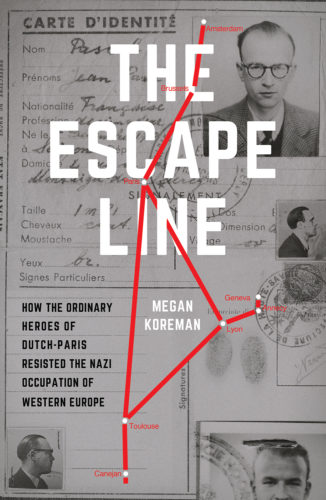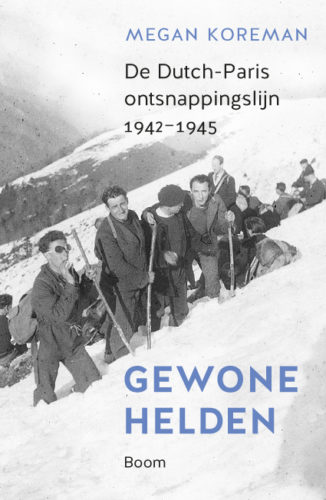Searching for the Dutch-Paris Escape Line
Although it would most probably be a serious misfortune to get involved with a corrupt police agent or civil servant today, it could have been a saving stroke of good luck during the second world war. On occasion, the corruption could be leveraged into escape.
For instance, there was a young teacher who lived in Hilvarenbeek on the Dutch/Belgian border who spent most of the war guiding desperate Jews from Amsterdam to Brussels. We’ll call him Mr Vos. In a 1994 interview, Vos said that there was only one time he was truly afraid. He had just crossed the Dutch border when a German rose up behind him Read the rest of this entry »
- 0 Comments
- Tags: Belgium, Border Crossings, Jews, The Netherlands
In July 1941 a young man we’ll call Frits (born 1918) left for England with a friend we’ll call Henk. They ran out of money in Valenciennes, France, and turned back to the Netherlands.
In order to support himself and his widowed mother, Frits took a job with the CCD in The Hague as a contraband food inspector. He always tried to let the individuals who were smuggling food for their own use go but cracked down on the black marketeers.
Apparently he did more than just look the other way because in May 1943 his mother (born 1900) was arrested for providing a false ID to a Jew and ration cards to about 10 Jews. The cards had actually come from Frits, but his mother took the blame Read the rest of this entry »
The Sticky Beaches of 1944
Although Dutch-Paris was mostly in the business of rescuing people, the line did also convey information. For the most part, the information was gathered by other people skulking about the peripheries of German military installations, plying officers with wine or simply and boringly counting the number of trucks that drove by. The information, whether it be about military affairs or the state of the food supply, was written up into reports, microfilmed and then carried across the continent rolled up in hairbrushes, fountain pens and the like.
And, of course, the Dutch-Paris couriers themselves would have been good sources of information, if only about public opinion, because they relied on their powers of observation to stay alive.
But there was always the taint of rumor on any clandestine information, and sometimes it could be hard to assess. For instance, in March or April of 1944, the Dutch military attaché in Switzerland sent a letter to his British counterpart. The general was an experienced and level-headed person but he was puzzled by a report he got from a “reliable Dutchman” who had heard the same story from four different sources in four different places in southwestern France.
According to all four of these people, the Germans had Read the rest of this entry »
- 0 Comments
- Tags: France
How Albert Joined the Resistance
On 29 July 1944 the Germans executed a Frenchman we’ll call Albert for what they called terrorism and aiding and abetting the enemy.
He was certainly guilty: he’d been in charge of organizing passages to Spain for Allied airmen and resistants from November 1942 until his arrest and subsequent torture in Toulouse on 15 May 1944. He appears to have been one of Dutch-Paris’s contacts in the French Resistance for getting people over the Pyrenees.
He was not, however, a local. He’d come to the Pyrenees after escaping from a POW camp Read the rest of this entry »
- 0 Comments
- Tags: arrests, France, Pyrenees
What to Call the Opposition?
While reading through all these documents in the Netherlands, Belgium and France, I’ve noticed something about the way that resisters referred to themselves during and immediately after the war. It wasn’t the same in all three countries.
In France, clandestine opposition to the German occupation was always known as la Résistance, the heroic efforts of the résistants. La Résistance translates pretty much directly into English as “The Resistance” only with a bit more élan than simple “resistance.” There’s dash, derring-do and danger wrapped up into the term, along with patriotism and heroism.
The French-speaking part of Belgium also uses the term la Résistance, but the Dutch-speaking, Flemish, part of Belgium talks about the Weerstand. Literally it means “the standing against” and has the same connotations of opposition as La Résistance.
Nowadays the Dutch usually talk about the Verzets Read the rest of this entry »
- 0 Comments
- Tags: Belgium, France, The Netherlands
Sardines in Her Majesty’s Secret Service
The Dutch government-in-exile in London had a problem that is today almost inconceivable: they didn’t know what was going on in the Netherlands. Nor did they have a way to communicate with the people they claimed to represent. They had to resort to clandestine means.
One such was to microfilm reports and instructions and then mail them to Switzerland, Sweden or Spain hidden in the bindings of obscure academic books. Following instructions telegrammed from London, the military attaché in, say, Bern would go to a particular Swiss bookseller and order a history of Javanese politics published in 1869 or a treatise on translating Sanskrit into Frisian. When it arrived he would slit open the cover and forward the microfilm on to London or the Netherlands.
The microfilms could also be sent by courier who carried them across the borders in fountain pens, Read the rest of this entry »
On 23 November 1943, two plain clothes German policemen arrested a Dutch banker in the train station in Antwerp, Belgium. The banker sat in a prison in Belgium for three months without being interviewed, was then transferred to an internment camp in the Netherlands where he was interviewed in an almost gentlemanly manner and then deported into the concentration camp system. The English liberated him from Bergen-Belsen in April 1945.
The Dutch banker, we’ll call him Jan, managed a branch office in Brussels. He appears to have been very busy transferring and exchanging money for the Dutch Resistance. For instance, the Hervormde Kerk sent 80,000 guilders to its pastor in Brussels for the support of Dutch refugees through our man, who converted it into Belgian francs. He was, then, under suspicion by the Deviezen Schutz Kommando (DSK) for contravening their laws about money.
But he was arrested as part of the “roll-up” of a pilot escape line run by a dangerously chatty Dutchman Read the rest of this entry »
Just because dossiers on resisters are now available, doesn’t mean that the dossiers have more information than a name and date of birth (sometimes not even that). But sometimes you can piece together a portrait out of bits from different archives.
Take the example of Dr. Dreyfus. I first came across the name in the Dutch Nationaal Archief on a list written by John Weidner. That’s all it said: Dr Dreyfus, a known colleague of Dutch-Paris.
Now that’s really not enough information. For one thing, was this Dreyfus French, Belgian or Dutch? Dreyfus is a fairly common name. To figure out which Dreyfus you need at least a first initial and preferably the full name and birth date. And then, of course, you’d like to know what it was that he did for Dutch-Paris. Read the rest of this entry »
- 0 Comments
- Tags: Border Crossings, France, Pyrenees
The Historical Hunt
Historical research is a little like hunting. You need to know what kinds of tracks your quarry leaves; it always helps to have a local guide, and timing makes all the difference.
For the most part historians follow paper trails, so we have to think about who would have written about our subjects and why. For instance, the men who wrote the Treaty of Versailles wrote all sorts of official memos, reports and proclamations that were diligently preserved by their governments. It’s a matter of notorious common sense, however, that resisters did not write things down and that the Gestapo burned their files.
But it turns out that common sense is wrong. Read the rest of this entry »
- 0 Comments
- Tags: France
I’ve come to Paris to try to figure out how it came about that over one hundred members of Dutch-Paris were arrested in February and March of 1944, many of them later dying in the concentration camps. John Henry Weidner was more than a little interested in the question himself, and, as a Captain in the Dutch Security Services, in a position to investigate it just after the war.
The original arrest in a long “roll-up” of arrests, happened on 11 February 1944 in Paris when French police arrested a young courier who we’ll call Erna (b. 1921). After her return from Ravensbruck in 1945, she confessed to having told the Germans everything they wanted to know after they tortured her and threatened her father.
I spent a day at the archives of the police looking at the purge dossiers of three officers involved in Erna’s arrest. I can’t say that I learnt very much from them except that they arrested her, which I already knew. She says they arrested her because she had a large bag of food, too much given the current rations. They say they arrested her because she had a false ID, but Dutch-Paris IDs were usually quite good. Read the rest of this entry »
- 0 Comments
- Tags: arrests, France, women

